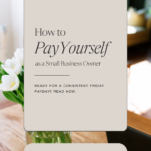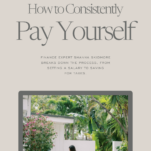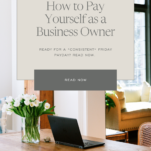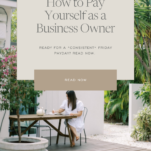Keep Reading
How to Pay Yourself as a Business Owner
If you’re part of the 65% of small business owners who don’t pay themselves consistently or the 27% funding your business with wages from another job…you aren’t alone! My hope is that todays post will help you finally take that consistent paycheck you’ve likely been longing for! Word on the street is that it’s normal […]

Paragraph
If you’re part of the 65% of small business owners who don’t pay themselves consistently or the 27% funding your business with wages from another job…you aren’t alone! My hope is that todays post will help you finally take that consistent paycheck you’ve likely been longing for!
Word on the street is that it’s normal not to make any money in the first few years of your business. And while that may be true for large corporations, for us small business owners, being able to pay yourself is a sign of health in your business (and actually super important)!
But, I totally understand that scheduling that paycheck can be tricky: from managing fluctuating sales to accounting for taxes… let’s dig into the big picture and nitty gritty details so you feel more equipped to make Friday paydays your new reality!
Why It’s Important to Pay Yourself Consistently
As a small business owner, you wear a lot of different hats: marketing, product design, customer service, bookkeeping, sales, and of course…CEO.
In your role as CEO, it makes sense not to take a paycheck until the business is profitable (aka there’s money left over after paying your expenses).
But most small business owners don’t realize that you’re not just the CEO—you’re also an employee of your business. The *STAR* employee! You’re the one writing the copy, making the widgets, and serving clients.
And as an employee of the business, you deserve to be paid for your time and efforts. You wouldn’t expect other employees to work for free, so you shouldn’t either!
3 Common Reasons why business owners neglect paying themselves
Before we walk through how to pay yourself as a business owner, it’s important to identify what’s been preventing you from taking a salary.
I’ve worked with thousands of entrepreneurs around the world and seen the behind-the-scenes of their finances. When someone tells me they aren’t taking a paycheck from the business, it usually comes down to one of three reasons:
1. Underpricing
The “perfect pricing formula” I teach in The Blueprint Model is your cost of goods x 2.5 markup (for wholesalers, that should be your wholesale price). Costs include everything that goes into creating and delivering your product or service—materials, labor, and most importantly, your time.
Most entrepreneurs believe that getting paid for your time is a luxury. We want to reframe that mindset early on by including your time as a part of the pricing equation.
Treat the time you spend working as you would for any employee. If you had to pay someone to do that work, how would you price your offers to cover their paycheck? Suzy employee wants to get paid, even if “Suzy employee” is you!
2. Overspending on Expenses
If your pricing is right but you still aren’t able to take a paycheck, it could be because you’re spending too much to run the business.
This is a common problem, especially for new entrepreneurs who try to follow advice like, “You have to spend money to make money” or “The goal is to not pay taxes”. Or the classic: “I reinvested profits back into the business.”
~tell me you don’t take a paycheck without telling me you don’t take a paycheck~ *wink*
Jokes aside, I hear statements like this all the time (even from so-called financial experts) and they always make me cringe inside.
Yes, it’s important to understand tax write-offs and reinvest into your business, but you should do so with the goal of increasing profits. Spending all of your profits without paying yourself is a hard habit to break later on.
I recommend spending no more than 50% of your total sales to run the business (overhead expenses if we are talking technical $$ jargon), including expenses like software, team, travel, and nice-to-have investments like education. That leaves extra to ensure there are enough funds to pay yourself and cover your tax bill!
For more tips on how to plan your business budget, check out this post.
3. Financial Fears
Most small businesses fail because they run out of money—not because they weren’t making enough, but because they didn’t know how to manage it. So it’s understandable if you’ve been hesitant to pay yourself.
*BUT* if you want to run a healthy, sustainable business, we need to unpack that old narrative of not being able to pay yourself and replace it with the income you’ve been dreaming of.
It might seem counterintuitive, but paying yourself consistently is actually the key to overcoming this fear. So let’s dig in!

How to Pay Yourself as a Business Owner
1. Determine Your Salary
The first step to paying yourself is to determine how much your salary will be. My recommendation is to start small. It’s better to pay yourself a consistent amount regularly than inconsistent amounts on a random schedule.
Why? Because fluctuating income is hard to plan a home budget around! The sooner you can create a predictable paycheck, the easier it will be to manage your personal finances (and as an entrepreneur, the two go hand-in-hand).
If you’re not sure how to plan your personal budget or how much your family needs on a monthly basis, check out Blueprint at Home!
✋ Have you been charging personal expenses to your business?
I hear from many small business owners who aren’t taking a paycheck but charge their personal expenses to the business. If that’s you, don’t hide in shame! This is super common and it’s actually a helpful baseline for your salary.
Every dollar you spend on personal expenses through the business is in fact you paying yourself! Instead of charging that next TJMaxx purchase to the business, let’s turn all that personal spending into an actual paycheck.
📌 A simple way to get started:
- Look back through your bank records for the past few months and add up how much you’ve charged to the business that is actually personal. For example, if you spent $1500 in the business over the past 3 months on personal expenses like groceries, gas, shopping, and eating out, let’s turn that into a $500 a month paycheck!
Why make the switch?
Separating your personal and business expenses will make tax time so much easier!! Not to mention there’s something powerful about seeing an actual paycheck (no matter how small) being transferred to your personal bank account.
Getting paid for the work you do is a powerful way to boost your mindset as a business owner!
When is the right time to Increase Your Pay?
When you can pay yourself a consistent amount for at least three months without feeling a strain on the business cash flow, that’s a sign that you’re ready to increase your salary!
I recommend paying yourself at least 20% of all sales. So if your business brings in $100,000 a year in total sales, you should pay yourself at least $20,000 (20%).
If you want to ease yourself into it, you can start with a smaller salary (like $1,000/month) and add a one-time “bonus” at the end of the year to make up the difference.
What about taxes?
A good rule of thumb is to set aside 30 cents for every dollar you pay yourself (or 30%) for taxes. So if you pay yourself $1,000/month, you’ll want to save $300/month for taxes!
2. Decide on a Pay Schedule
Marie Forleo says, “If it’s not scheduled, it’s not real.”
The easiest way to get started is to pay yourself weekly rather than monthly, so you can establish the habit of moving money (however small an amount) to your personal account. Once you choose a date, schedule your transfers to send automatically so you don’t need to think about it.
There are lots of different systems out there to keep you organized, from accounting software like Quickbooks to a good old-fashioned spreadsheet. You can also outsource to a bookkeeper if that makes financial sense for your business.
Whichever method you choose, make sure you keep detailed records of every transaction!
3. Manage Your Cash Flow
Cash flow is everything. To avoid running low on funds and not being able to pay your expenses, save up a buffer.
Set aside an emergency fund to cover at least six months of expenses in your business and personal life (check out The Blueprint Model for your business and Blueprint at Home for the personal finance side).
If you run a seasonal business where sales fluctuate, save extra cash during high-revenue months to pay your salary in the slow season. The longer you’re in business, the better you’ll be able to predict your revenue throughout the year.
Here are a few of the most common cash flow systems to help you manage your money:
Profit First
It says it right there in the title! In this method, you take a profit and pay yourself first, before paying your expenses. The exact amounts are based on a percentage model, where you distribute money to separate accounts for profit, owner’s pay, tax savings, and expenses.
The Envelope System
This classic system helps you categorize your spending by setting funds aside for specific expenses (including your paycheck!). As your business earns money, you distribute it among the different envelopes and when an expense comes due, you withdraw the funds from that envelope.
Bucket Budgeting
You can use as many buckets as you’d like, but the most common method includes three main categories: fixed expenses (which remain the same every month, like a software subscription), variable expenses (one-time purchases like a new website template), and savings (for your pay and emergency fund).
SHOP: Cash Flow Planning Spreadsheet
4. Payroll? Owners Draw? The technical stuff.
You may be wondering about the technical details of how to pay yourself “correctly” and stay out of trouble with the IRS! That depends on how your business is licensed:
- If you’re a Sole Proprietor or Singe-Member LLC: You take “owner’s draw” or “distributions” which are more flexible and can be varying amounts on any schedule.
- If you’re an S Corp: A portion of your pay is paid through payroll (so taxes are accounted for) while another portion is paid through owner’s draw, which is subject to self-employment tax.
Don’t get overwhelmed by all the jargon! The main difference is that as a sole proprietor, YOU and YOUR BUSINESS are one and the same. Every dollar the business makes as profit counts as your personal income that you’ll need to pay taxes on.
As an S corp, you and your business are financially separate. Some entrepreneurs prefer this option because there are more strategies you can take advantage of to lower your tax bracket.
If you live outside the US, know your country’s rules and get advice from a tax professional!
Final Thoughts on How to Pay Yourself as a Business Owner
Don’t believe anyone who tells you it takes years to make money in a small business. Consistent profits are a sign of a healthy business!
Your business can (and should) be profitable from the first time you sell something. All you need to do is set aside a portion of that first sale and put it toward your owner’s pay, then follow the steps in this post.
Paying yourself a regular paycheck ensures you’re taking care of your business’s most important asset: its owner!
Need help getting your small business finances in shape?
💸 The Blueprint Model : My Signature 12-week Business + Finance Program to Simplify The Math of Business
🌟 My Blueprint Year : Annual Planning Course + 350-page Planner/Business Tracker
🏠 Blueprint at Home : My Personal Budgeting Course
Keep Reading:
Five Numbers to Know and Track in Your Business
A 3-Step Plan to Replace Your Corporate Salary with Business Income
How to Manage Small Business Finances | Monthly Money Workflow
SHARE THIS:
May 13, 2024
Previous Post:
Next Post:







And if you found this helpful, share with your friends!